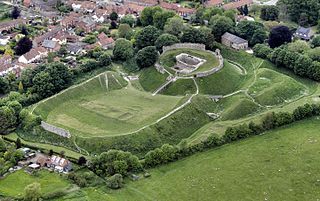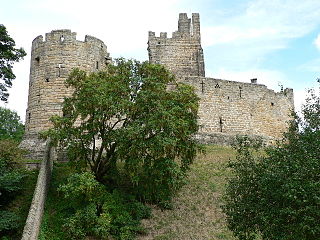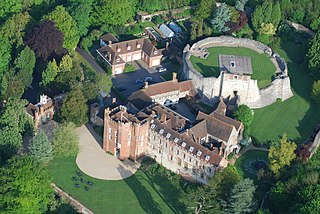
Dorchester Castle was a motte and bailey castle in the market town of Dorchester, Dorset, southern England (grid reference SY692909 ).

Dorchester Castle was a motte and bailey castle in the market town of Dorchester, Dorset, southern England (grid reference SY692909 ).
The date that the castle was built is unclear. [1] Between 1154 and 1175 it was in possession of the Earl of Cornwall and it had become a royal possession by 1185. Both Henry III and John spent money on the castle. [2] It appears to have been disused from about 1290 and there are references to its stonework being reused by the Chidlock family to build Dorchester Greyfriars in 1309. [2] [3] [4] [5] Certainly it was abandoned by 1422. [6]
Dorchester Prison occupies its site – originally to the north of the town, with a Franciscan Priory further east, but nothing of the castle or the priory remain. [7] However, in 1720, two underground passages were discovered while building a chapel: these once connected the castle to the town proper. [8] In the 1800s, a bastion-like rampart still existed, and a small rampart and ditch were visible on the north and east sides. [8] The gatehouse was built in 1790 and has been designated as a Grade II listed building. [9]
Great Western Railway Castle-class locomotive No. 4090 was named after the castle. [10]
There are some records of people associated with the castle:

Lancaster Castle is a medieval castle in Lancaster in the English county of Lancashire. Its early history is unclear, but may have been founded in the 11th century on the site of a Roman fort overlooking a crossing of the River Lune. In 1164, the Honour of Lancaster, including the castle, came under royal control. In 1322 and 1389 the Scots invaded England, progressing as far as Lancaster and damaging the castle. It was not to see military action again until the English Civil War. The castle was first used as a prison in 1196 although this aspect became more important during the English Civil War. The castle buildings are owned by the British sovereign as Duke of Lancaster; part of the structure is used to host sittings of the Crown Court.

Dorchester is the county town of Dorset, England. It is situated between Poole and Bridport on the A35 trunk route. A historic market town, Dorchester is on the banks of the River Frome to the south of the Dorset Downs and north of the South Dorset Ridgeway that separates the area from Weymouth, 7 miles (11 km) to the south. The civil parish includes the experimental community of Poundbury and the suburb of Fordington.

Beeston Castle is a former Royal castle in Beeston, Cheshire, England, perched on a rocky sandstone crag 350 feet (107 m) above the Cheshire Plain. It was built in the 1220s by Ranulf de Blondeville, 6th Earl of Chester (1170–1232), on his return from the Crusades. In 1237, Henry III took over the ownership of Beeston, and it was kept in good repair until the 16th century, when it was considered to be of no further military use, although it was pressed into service again in 1643, during the English Civil War. The castle was slighted in 1646, in accordance with Cromwell's destruction order, to prevent its further use as a bastion. During the 18th century, parts of the site were used as a quarry.

Castle Acre Castle and town walls are a set of ruined medieval defences built in the village of Castle Acre, Norfolk. The castle was built soon after the Norman Conquest by William de Warenne, the Earl of Surrey, at the intersection of the River Nar and the Peddars Way. William constructed a motte-and-bailey castle during the 1070s, protected by large earthwork ramparts, with a large country house in the centre of the motte. Soon after, a small community of Cluniac monks were given the castle's chapel in the outer bailey; under William, the second earl, the order was given land and estates to establish Castle Acre Priory alongside the castle. A deer park was created nearby for hunting.

Bramber Castle is a Norman motte-and-bailey castle formerly the caput of the large feudal barony of Bramber long held by the Braose family. It is situated in the village of Bramber, West Sussex, near the town of Steyning, overlooking the River Adur.

Christchurch Castle is a Norman motte and bailey castle in Christchurch, Dorset, England. The earliest stonework has been dated to 1160. The castle's site is inside the old Saxon burh dominating the River Avon's lowest crossing.

Ascot d'Oilly Castle is situated north of the village of Ascott-under-Wychwood in the north west region of Oxfordshire. It is a scheduled ancient monument. A fragment of the castle remains and is a Grade II listed building. It was named after Roger d'Oilly who was granted it by William the Conqueror and whose brother built Oxford Castle. It is thought that the castle was built around 1129 and it was demolished soon after 1175. There are fragmentary remains of a stone tower. The remains consist of raised ground surrounded by broad ditching.
Banbury Castle was a medieval castle that stood near the centre of the town of Banbury, Oxfordshire. Historian John Kenyon notes that the castle is "remarkable for its early concentric shape".

Barnstaple Castle stood near what is now the centre of the town of Barnstaple, Devon. When it was built, it was on the western side of the fortified town and commanded a good view of both the town and its important river crossings. The castle was built on top of an early medieval cemetery.

Chichester Castle stood in the city of the same name in West Sussex. Shortly after the Norman Conquest of England, Roger de Montgomery ordered the construction of a castle at Chichester. The castle at Chichester was one of 11 fortified sites to be established in Sussex before 1100. The Rape of Chichester, a subdivision of Sussex, was administered from the castle and was split off from the larger Rape of Arundel; a Rape was an administrative unit originating in the Saxon era and continued by the Normans. Situated in the north-east corner of Chichester, the castle was protected by the city walls. As it was an urban castle inserted into a pre-existing settlement, buildings were probably cleared to make way for the castle. Chichester Castle was of timber construction; although some timber castles were rebuilt in stone, there is no evidence that this was the case at Chichester.
Eardisley Castle was in the village of Eardisley in Herefordshire, England, 11 km north-east of Hay-on-Wye. The site of the castle is a scheduled monument.

Ewyas Harold Castle was a castle in the village of Ewyas Harold in Herefordshire, England.

Gloucester Castle was a Norman-era royal castle situated in the city of Gloucester in Gloucestershire, England. It was demolished in 1787 and replaced by Gloucester Prison.

Lewes Priory is a part-demolished medieval Cluniac priory in Lewes, East Sussex in the United Kingdom. The ruins have been designated a Grade I listed building.

Hereford Castle is a castle that used to be in the cathedral city of Hereford, the county town of Herefordshire, England. Founded sometime before 1052, it was one of the earliest castles in England. Hereford Castle was probably destroyed when the Welsh sacked Hereford in 1055, but seems to have been replaced by the following decade. During the civil war, when Stephen sought to usurp Queen Matilda, the castle was besieged three times; the garrison surrendered each time and control of Hereford Castle changed hands.

Michelham Priory is the site of a former Augustinian Priory in Upper Dicker, East Sussex, England, United Kingdom. The surviving buildings are owned and administered by the Sussex Archaeological Society and are Grade I and Grade II listed.

Prudhoe Castle is a ruined medieval English castle situated on the south bank of the River Tyne at Prudhoe, Northumberland, England. It is a Scheduled Ancient Monument and a Grade I listed building.

Farnham Castle is a 12th-century castle in Farnham, Surrey, England. It was formerly the residence of the Bishops of Winchester.

Kings Langley Palace was a 13th-century Royal Palace which was located to the west of the Hertfordshire village of Kings Langley in England. During the Middle Ages, the palace served as a residence of the Plantagenet kings of England. It fell into disuse sometime during the 16th century and became a ruin. Today, nothing remains of the building except for some archaeological remains. The site is a scheduled ancient monument.

HM Prison Dorchester was a local men's prison, located in Dorchester in Dorset, England. The prison was operated by Her Majesty's Prison Service, and closed in January 2014.
Coordinates: 50°43′01″N2°26′13″W / 50.717°N 2.437°W